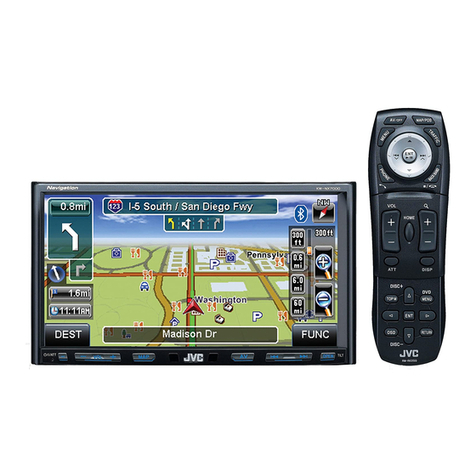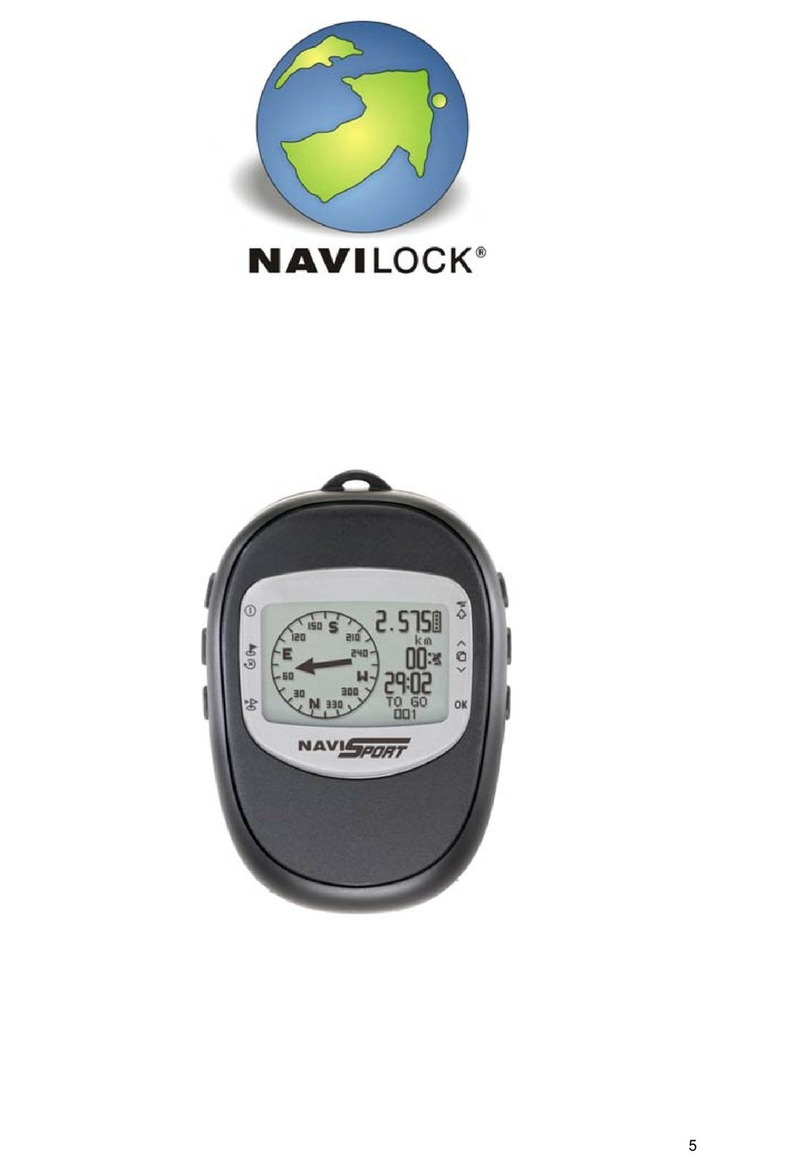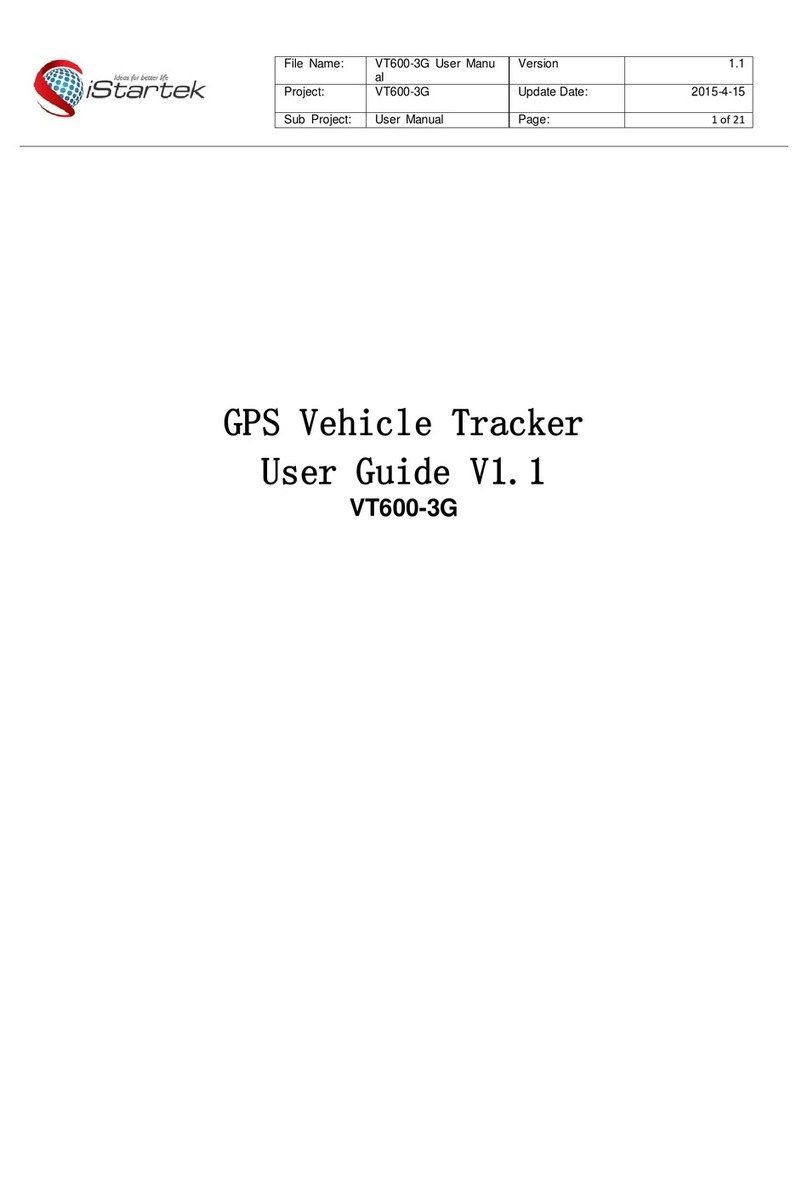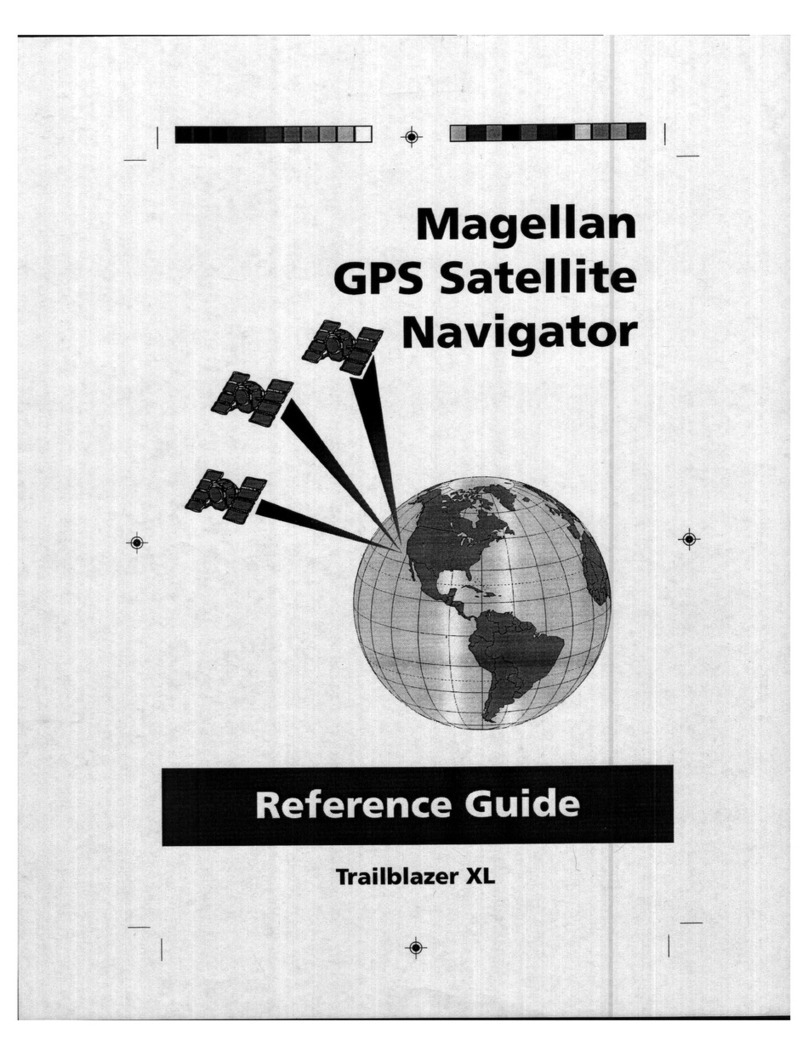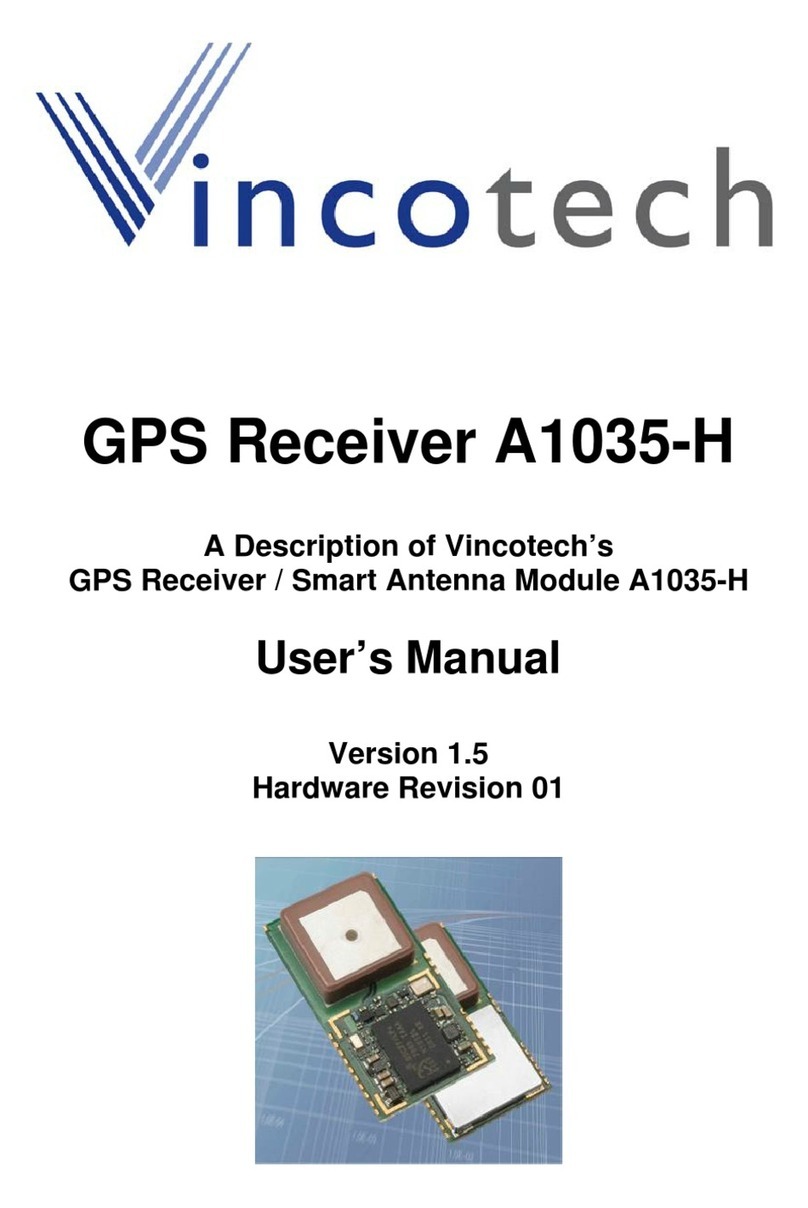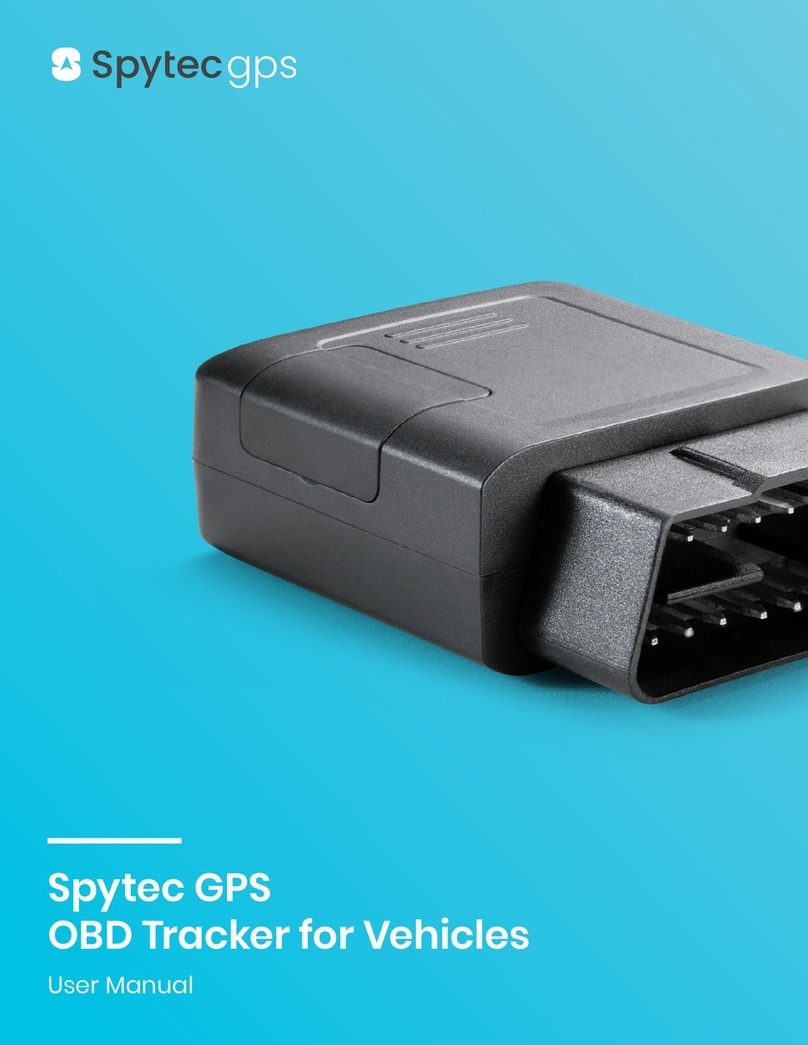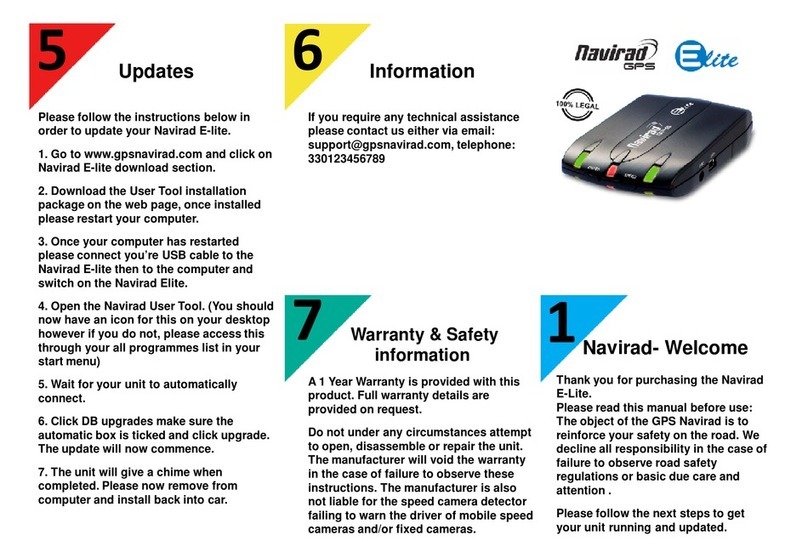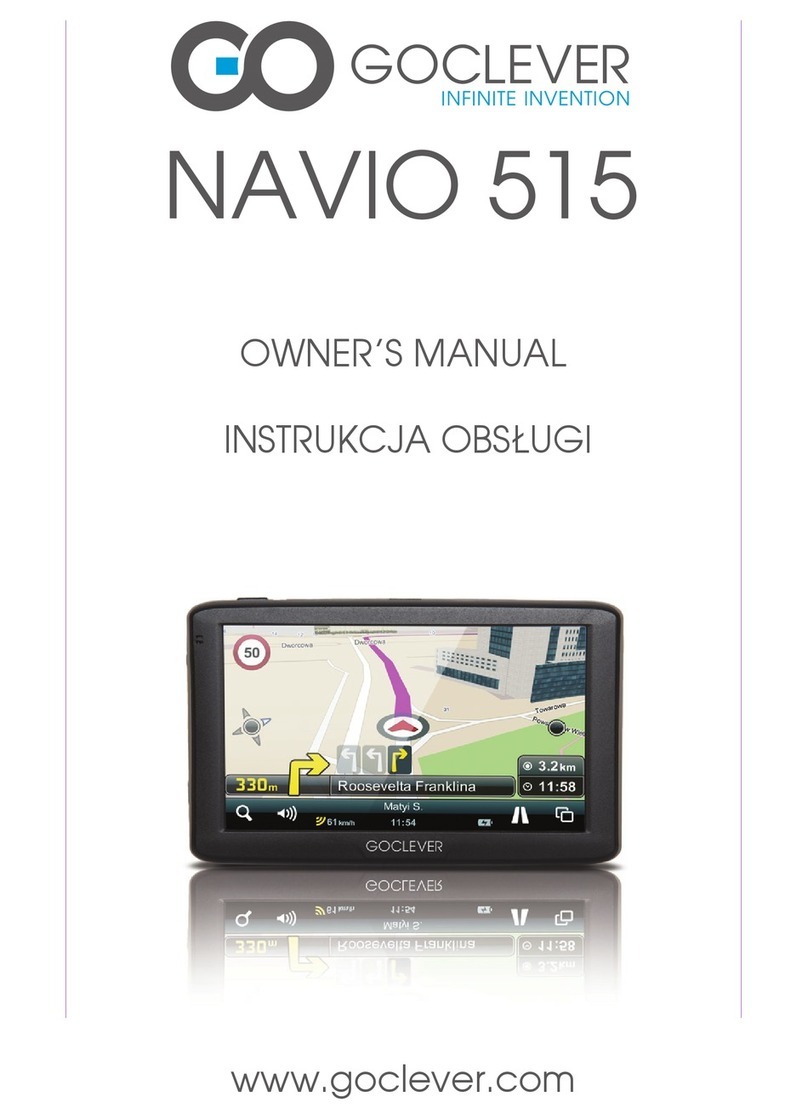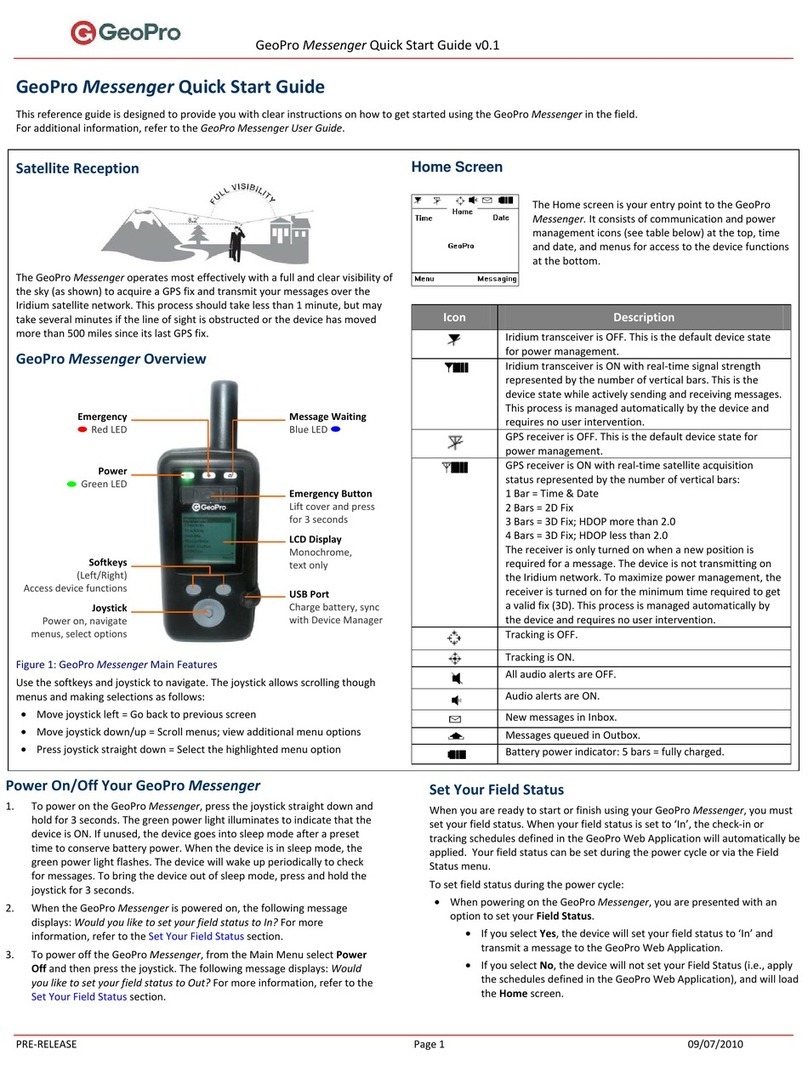geotik GPS LOGISTIC PRO User manual


Contents
1. Release history ................................................................................................................................ 3
2. Hardware......................................................................................................................................... 6
2.1. Technical details GLP 2.0............................................................................................................. 6
2.2. Technical details GLP 1.5............................................................................................................. 8
2.3. LED indicator GLP 1.5 .................................................................................................................. 9
2.4. LED indicator GLP 2.0 .................................................................................................................. 9
2.4 Installation guidance GLP 1.5 .................................................................................................... 10
2.5 Installation guidance GLP 2.0 .................................................................................................... 11
2.6 EcoDriving.................................................................................................................................. 13
2.7 Search for CAN data .................................................................................................................. 13
2.8 Bluetooth interface for technical support (optional)................................................................ 15
3 Commands and variables .............................................................................................................. 16
3.4 Telephone lock level.................................................................................................................. 16
3.5 Executable commands .............................................................................................................. 17
3.6 Read-only variables ................................................................................................................... 22
3.7 Configuration variables ............................................................................................................. 22
4 Configuration of basic functions ................................................................................................... 34
4.4 Unlock the device ...................................................................................................................... 34
4.5 Communication with server ...................................................................................................... 34
4.6 Update procedure ..................................................................................................................... 34
4.7 Update procedure over USB connection for GLP 2.0................................................................ 35
5 Firmware changelog GLP 2.0......................................................................................................... 35
6 Firmware changelog GLP 1.5......................................................................................................... 37
7 Error codes .................................................................................................................................... 42
7.4 From GSM modem .................................................................................................................... 42
7.5 From HTTP server ...................................................................................................................... 43
7.6 Update Errors ............................................................................................................................ 43
8 Data Acquisition Triggers............................................................................................................... 44
9 Jamming / interference monitor reported states ......................................................................... 45
10 Indicators from CANbus ............................................................................................................ 46

1. Release history
Document version
Description
12/12/20
•Please check http://bit.ly/GLP_-_changelog
10/09/20
•
Added GSM module update in GLP 2.0 firmware (.dfotaupdate). Requires firmware 1.02.39
or later.
•Added new Data Acquisition Trigger #246
22/08/20
•Updated GSM_CFG description. APN and GSM module mode works from firmware version
1.02.37 (GLP 2.0 only)
06/08/20
•
Corrected SafeCAN connection in GLP 2.0
05/08/20
•Updated IGNITION_CFG to reflect current options
23/07/20
•Corrected reason of acquisition number from 65 to 68 - Immobilizer ON (active)
•Added DroneKey integration
06/07/20
•Updated GSM module details
29/06/20
•Updated GLP 1.5 schematic
12/06/20
•Added firmware update over USB connection for GPL 2.0
•GLP 2.0 changelog link added
•.bootupdate added to firmware 1.02.19
07/05/20
•GLP 2.0 PCB layout updated to version 2.0.3; tamper detection hardware foundation added
•Installation guidance GLP 2.0 updated
27/04/20
•Updated description of CAN_ID – Bank2 added and FLAG description edited
1.02.19 / 4.02.19
08/04/20
•Added .accauto – autocalibration process.
14/02/20
•Added jamming reported states for older firmware
•Restored release history from GLP 1.5 and older
07/02/20
•Added indicators from CANbus
05/02/20
•Corrected wiring diagram on Installation Guidance page
04/02/20
•
Acquisition trigger – added description; available from fw 2.71.50 / 3.10.50 / 4.1.50
•Jamming/interference monitor reported states
1.02.11
20/09/19
•New firmware
1.02.10
06/09/19
•New firmware
1.02.09
20/08/19
•New firmware
1.02.08
15/08/19
•New firmware
1.02.07
18/07/19
•New firmware
•Added new functions: .updcmd & .gprscmd
1.02.06
11/07/19
•New firmware
1.02.05
19/06/19
•New firmware
1.02.03
07/06/19
•New firmware
1.02.02
30/05/19
•New firmware
1.02.1
29/05/19
•New firmware
1.01.63
02/08/2019
•New firmware

1.01.62
01/08/2019
•
Added GLP 2.0
V4.01.11
18/12/17
•New firmware
V3.10.09/V4.01.09
V5.01.09/V7.01.09
16/11/17
•New firmware
V4.01.08
29/10/17
•New firmware
V4.01.07
22/10/17
•New firmware
V2.72.06/V3.10.06
V4.01.06/V5.01.06
V7.01.06
11/10/17
•New firmware
V2.72.02/V3.10.02
V4.01.02/V5.01.02
V7.01.02
27/08/17
•New firmware
V2.72.01/V3.10.01
V4.01.01/V5.01.01
V7.01.01
20/08/17
•New firmware
V2.71.09/V3.09.09
V4.00.09/V5.00.09
V7.00.09
08/06/17
•New firmware
V2.71.01/V3.09.01/01
08/05/17
•New firmware V2.71.01/V3.09.01
V2.71.00/V3.09.00/01
20/02/17
•New firmware V2.71.00/V3.09.00
•New chapter “Bluetooth interface for technical support”
V2.70.02/V3.08.02/01
08/11/16
•New firmware V2.70.02/V3.08.02
V2.70.01/V3.08.01/01
13/09/16
•New firmware V2.70.01/V3.08.01
V2.69.06/V3.07.06/01
11/08/16
•New firmware V2.69.06/V3.07.06
V2.69.05/V3.07.05/01
27/07/16
•
New firmware V2.69.05/V3.07.05
V2.69.02/V3.07.02/01
07/07/16
•New firmware V2.69.02/V3.07.02
V2.69.01/V3.07.01/01
28/06/16
•New firmware V2.69.01/V3.07.01
V2.68.06/V3.06.06/01
22/06/16
•New firmware V2.68.06/V3.06.06
V2.68.04/V3.06.04/01
16/06/16
•New firmware V2.68.04/V3.06.04
V2.68.02/V3.06.02/01
17/05/16
•New firmware V2.68.02/V3.06.02
V2.67.08/V3.05.08/01
29/02/16
•New firmware V2.67.08/V3.05.08
V2.67.05/V3.05.05/01
17/02/16
•New firmware V2.67.05/V3.05.05
V2.67.03/V3.05.03/01
10/02/16
•New firmware V2.67.03/V3.05.03
•Added “Camera Data” in protocol
V2.66.03/V3.04.03/01
02/02/16
•New firmware V2.66.03/V3.04.03
V2.66.01/V3.04.01/01
20/01/16
•New firmware V2.66.01/V3.04.01
V2.65.01/V3.03.01/01
14/12/15
•
New firmware V2.65.01/V3.03.01

V2.64.06/V3.02.06/01
09/12/15
•
New firmware V2.64.06/V3.02.06
•New chapter “GLP extension hack – mounting instruction”
V2.64.03/V3.02.03/01
26/10/15
•New firmware V2.64.03/V3.02.03
V2.63.06/V3.01.09/01
08/10/15
•New firmware V2.63.06/V3.01.09
V2.63.04/V3.01.07/01
25/09/15
•New firmware V2.63.04/V3.01.07
•Added “Info 32” (terminal confirmation) in protocol
V2.63.03/V3.01.06/01
15/09/15
•New firmware V2.63.03/V3.01.06 (3G version)
•In protocol added new function to parameter 11
V2.62.08.01
11/09/15
•New firmware V2.62.08
V2.62.06.01
28/08/15
•New firmware V2.62.06
•Added beta version package
V2.62.04.01
18/08/15
•
New firmware V2.62.04
V2.62.03.01
17/08/15
•New firmware V2.62.03
V2.61.05.01
28/07/15
•New firmware V2.61.05
•In protocol added string parameter 244 and all string parameters are shortened to 64 bytes
V2.60.05.01
15/07/15
•New firmware V2.60.05
V2.60.03.01
13/07/15
•New firmware V2.60.03
V2.60.02.01
07/07/15
•New firmware V2.60.02
V2.59.15.01
10/06/15
•New firmware V2.59.15
•New chapter “Search for CAN data”
V2.59.14.01
08/06/15
•
New firmware V2.59.14
•Changes in protocol – CSQ and High Resolution Speed
V2.59.10.01
22/05/15
•
New firmware V2.59.10
•New chapter “LED indicator”
•New chapter “EcoDriving”
V2.58.11.02
21/04/15
•New chapter “Technical details”
•Added eco driving parameters to protocol
V2.58.11.01
08/04/15
•New firmware V2.58.11
•Added Information about supported parameters by FW
V2.58.06.01
26/03/15
•New firmware V2.58.06
•Added a few error codes
•Fix description about EVENTS and ACTIONS
•New subsection “Update Errors”
V2.57.02.01
05/02/15
•New firmware V2.57.02
•Added information in “Installation guidance”
V2.56.01.02
21/01/15
•Added information about SafeCan
V2.56.01.01
16/01/15
•New firmware V2.56.01
V2.55.02.01
05/01/15
•New firmware V2.55.02
V2.55.01.01
15/12/14
•New firmware V2.55.01
•Changes in protocol – param 1
V2.54.12.01
28/11/14
•New firmware V2.54.12
V2.54.05.01
25/11/14
•New firmware V2.54.05
V2.54.03.01
30/10/14
•
New firmware V2.54.03
•New variables
•Editorial corrections
V2.53.02.02
02/09/14
•Fix in update chapter and installation guidance

V2.53.02.01
26/06/14
•
New firmware V2.53.02
V2.53.01.01
16/06/14
•New firmware V2.53.01
•New commands and variables
•New chapter “Error codes”
V2.52.05.02
27/05/14
•QR codes added
V2.52.05.01
05/05/14
•New firmware V2.52.05 and V2.52.04
•New commands and variables
•New chapter “Telephone lock level”
V2.52.02.02
30/04/14
•
Protocol chapter reorganization
•Fix - SERVER_CODING default is 0, not 1
•Add date to release history and firmware changelog
V2.52.02.01
24/03/14
•
New firmware V2.52.02
V2.52.01.02
03/03/14
•
Protocol added
V2.52.01.01
24/02/14
•
Document created
2. Hardware
2.1. Technical details GLP 2.0
Element
Specification
Interface
•Power supply 7 – 36 V
•3x Analog input, 0 – 36V, 12bit, 1600Hz, averaging of 1024 samples
•7x Digital inputs
•RS485 A/B interface
•K-Line interface
•2x CAN-H, CAN-L (SAE J1939, SAE J2411)
•SafeCAN connector (CAN-H, CAN-L) SAE J1939
•4x Digital output, open collector, max 2A
•1x OneWire
•5V output for SafeCan or OneWire devices
•Optional encrypted (AES256) wireless connection on 869.525Mhz (Sub Ghz RF module)
•Optional Bluetooth
•2xLED status
•MiniSIM card slot
•Antenna connectors SMA female outer shell, female inner pin
GSM module (2G, LTE
Cat.M1/NB-IoT)
•LTE Cat M1/Cat NB1/EGPRS module
maximum data rate of 300Kbps downlink and 375Kbps uplink
•Cat M1/Cat NB1:
•LTE FDD: B1/B2/B3/B4/B5/B8/B12/B13/B18/
B19/B20/B26/B28
•LTE TDD: B39 (For Cat M1 Only)
•2G (EGPRS):
850/900/1800/1900MHz
•The transmitter power: max. power: 23dBm
GNSS module
•System support: GPS, GLONASS, BeiDou/Compass, Galileo, QZSS
•Sensitivity:
oTracking: -157 dBm
oReacquisition: -157 dBm
oCold start: -146 dBm
•Hot start < 2.7sec
•TTFF
oCold start (open sky): 31s (autonomous); 11.54s (XTRA enabled)
oWarm staty (open sky): 21s (autonomous); 2.52s (XTRA enabled)
oHot start (open sky): 2.7s (autonomous); 1.82s (XTRA enabled)
•Horizontal position accuracy: < 2.5m (CEP 50%; autonomous, open sky)

Power consumption
•
Sleep mode – 7.3mA @ 12V, 3mA @ battery
•Normal mode - 70mA @ 12V, 90mA @ battery
•Sending data - 250mA @ 12V, 350mA @ battery
•MAX (Battery charging) – 350mA @ 12 V
Environmental
conditions
•Operating temperature –20°C to 70°C (battery charging from 0°C to 45°C )
•Storage temperature –40°C to 80°C (excluding battery – prolonged storage –20°C to 25°C)
•Operating humidity up to 95% (non-condensing)
•Increased Impact resistance
•High resistance to vibration
•Size (LDW): 77 x 70 x 27.25 mm
Additional
information
•Memory can store 10000-40000 data sets, it depends on how many parameters it collects.

2.2. Technical details GLP 1.5
Element
Specification
Interface
•Power supply 9 – 36 V
•1x Analog input, 0 – 36V, 12bit, 1600Hz, averaging of 1024 samples
•2x Analog inputs (optional) 0 - 36V, 12bit, 1600Hz, averaging of 1024 samples shared with RS
interface*
•5x Digital inputs
•RS232 (standard) or RS485 A/B interface (optional)
•CAN-H, CAN-L (SAE J1939) with OBD2 connector
•1x Digital output, open collector, max 2A
•1x Digital output (optional) , open collector, max 2A**
•1x OneWire
•1x pulse input, tested up to 20kH, shared with DIN1
•Dedicated SafeCAN connector (CAN-H, CAN-L) SAE J1939
•5V output for SafeCan or OneWire devices
•Encrypted (AES256) wireless connection on 869.525Mhz (Sub Ghz RF module)
•LED status
•SIM card slot
•Antenna connectors SMA female outer shell, female inner pin
* Either two additional inputs or RS interface
** Either one additional output or oneWire
GSM module (2G)
•Quad-band 850/900/1800/1900 Mhz
•GPRS class 8 + 10
•The transmitter power:
- 2W @ 850/900 Mhz
- 1W @ 1800/1900MHZ
•Built-in omnidirectional antenna or external antenna
GSM module (3G)
optional
•Dual-Band UMTS/HSDPA 850/1900MHz or UMTS/HSDPA 900/2100MHz
•Quad-band 850/900/1800/1900 Mhz
•GPRS and EDGE class 12
•The transmitter power:
- 0.25W @ UMTS 850/900/1900/2100 Mhz
- 2W @ GSM 850/GSM900 Mhz
- 1W @ DSC 1800/PCS1800 Mhz
•
External antenna
GSM module (LTE)
optional
•LTE Cat M1/Cat NB1/EGPRS module
maximum data rate of 300Kbps downlink and 375Kbps uplink
•Cat M1/Cat NB1:
•LTE FDD: B1/B2/B3/B4/B5/B8/B12/B13/B18/
•B19/B20/B26/B28
•LTE TDD: B39 (For Cat M1 Only)
•EGPRS:
•850/900/1800/1900MHz
•The transmitter power: max. power: 23dBm
Built-in omnidirectional antenna or external antenna
GPS module
•50 channels
•Hot start < 1sec
•Cold start < 27sec
•Horizontal position accuracy < 2.5m (CEP, 50%)
•Receiver sensitivity -161dBm
•Built-in active antenna or external active antenna
Bluetooth module
optional
•4800 to 1382400bps communication speed
•Current: 40mA max.
•Output Power: -4 to +6dbm Class 2
•Range: up to 20m
•PIN-secured communication
•Ability to set PIN
•Ability to set signature
Power consumption
•Sleep mode – 7.3mA @ 12V, 3mA @ battery
•Normal mode - 70mA @ 12V, 90mA @ battery
•Sending data - 250mA @ 12V, 350mA @ battery
•MAX (Battery charging) – 350mA @ 12 V

Environmental
conditions
•
Operating temperature –20°C to 55°C
•Storage temperature –40°C to 60°C
•Operating humidity up to 95% (non-condensing)
•Enclosure protection rating IP54
•Increased Impact resistance
•High resistance to vibration
•Size (LDW): 136 x 80.15 x 18 mm, SMA GPS or GSM antenna connector +6.8 mm in length.
Additional
information
•Memory can store 10000-20000 positions, it depends on how many parameters it collect
2.3. LED indicator GLP 1.5
Mode
Blinking
OFF
Normal
2 seconds
GPS problem
2 seconds
GSM problem
2 seconds
GPS & GSM problem
2 seconds
Sending data
Sleep
5 seconds
2.4. LED indicator GLP 2.0
Mode
Blinking
OFF
Normal
2 seconds
GPS problem
2 seconds
GSM problem
2 seconds
GPS & GSM problem
2 seconds
Sending data
Sleep
5 seconds
Mode
Blinking
OFF
Normal
2 seconds
CAN problem
2 seconds

2.4 Installation guidance GLP 1.5

2.5 Installation guidance GLP 2.0

SafeCANs were modified. There is one additional wire which need to be connected to GND.
IMPORTANT:
Firstly always connect the VCC and GND main beam (power), then SafeCAN - never the other way around. Connection
contactless converter (SafeCAN) without main beam will leads to device damage during the first or re-connection of
power. One of symptoms of injury is quickly overheating.
During using these SafeCANs please do not enable SafeCANs (3 wire) options in configurator. GLP configuration have
to be the same like without it

2.6 EcoDriving
EcoDriving is a functionality that allows measurement of driver behaviours (harsh acceleration, braking and
turning). GLP has implemented it in two different ways of measurement:
•based on GPS,
•based on accelerometer.
•based on accelerometer; counting events only
Accelerometer is standard feature of GLP. In all modes, when measurement reaches the specified threshold
value, GLP saves position with true flag on special harsh parameter built in protocol. Additionally it saves reached
value in specified by user parameter (or its counter).
On GLP we recommend to use EcoDriving based on accelerometer. Measurement are taken at 25Hz and they are
not affected to error caused by poor GPS signal. Cornering works above 30km/h to limit false alarms during
parking etc.
To use EcoDriving based on accelerometer data you need to calibrate accelerometer in two steps:
1. Calibration in a car after installation. This calibration is necessary to determine direction of device
(installation do not require mounting device on any special position, it requires device to be fixed
permanently in vehicle to a sturdy structure). Vehicle should stay on a flat surface and should not
move. You can start calibration procedure using sms/tcp command “.acccalcar”/”@acccalcar”. During
the first 10 seconds device determines up/down direction. After the answer: “ACC Calibration in car
READY – slowly GO and rapidly STOP on flat surface” you have 60 second to slowly move and rapidly
stop vehicle. It is necessary to move straight ahead and then the braking with force much greater than
acceleration. Value of the force is not important so you can move just 2-3 meters. This determines
forward/backward direction. After you stop you have to wait for the answer: “ACC Calibration in car
SUCCESS” before you move vehicle again.
2. Autocalibration after installation is done is possible. Please refer to .accauto command.
Only precisely and carefully calibrated device will guarantee the correct measurements. Bold expression are
the most important parts of the process!
You can use also EcoDriving based on GPS. There is no need to do any special calibration. That EcoDriving is
limited by technology to 1Hz measurment. To prevent false alarms (caused by GPS drift) harsh acceleration and
braking work when speed is above 10km/h, cornering works above 30km/h.
Warning! Accelerometer does not work when you are connected to GLP 1.5 using wireless dongle.
2.7 Search for CAN data
GLP has the ability to scan CAN bus to find interesting data. It provides a few functions to do that.
How to find proper connection?
.testcan/@testcan – Test of CAN connection. Device search data on 8 different speed (46, 50, 62, 83, 100, 125,
250, 500), in the case of success it sends answer with proper speed and number of frames. In case of failure it
sends “Not found”. 170 frames is a maximum which GLP can count. Waiting for an answer about 2min. Answer
via SMS or TCP (./@).
How to see raw data from CAN bus?
.cansearch - Request for raw data from CAN bus, device has to have CAN enable and properly configuration of
CAN speed. After word “CANID:” always is time stamp in unix format. 170 frames is a maximum which GLP can
send. Answer is always via GPRS.
Example of answers (since FW 2.59.15):

Without data:
CANID:1433831715;
With proper data:
CANID:1433831715;00000101=0100000000000000;00000119=0700000000000000;00000113=4400300000673
300;00000123=4400300000673300;
How to find long term information such distance or fuel level?
.fcansearch X- Activates periodic cansearch when ignition is on. X is a time in minutes, if set to 0 periodic
cansearch will be disable. After device reset this functionality will be automatically disabled.
It is necessary to collect data from few days. To do that you have to set device to send data to our proxy server
and enable periodic cansearch:
.set SERVER_HOST proxy.gpsguardian.pl
.set SERVER_PORT 8889
.fcansearch 1
Next contact with us. Give us information about GLP IMEI, address and port of your server (to forward data),
vehicle information (model, year of production, engine) and all information what do you want to get: vehicle
distance, motohours, tank capacity etc. We will add device to our server. Proxy will forward data to your server
and write it to file that we will analyse.
How to find short term information like RPM or position of pedals?
.startcansearch - Enable continuously cansearch. When it is working GLP does not send positions. After device
reset this functionality will be automatically disabled. You can disable it using .stopcansearch function too.
To do that you have to enable continuously cansearch. Next you have to do some states in vehicle, for example,
push acceleration pedal in 25%, next in 50%, 75% and 100% or open doors, close it, etc. First and last state have
to be without any event (only ignition on, engine off). All the time we need only one change in the vehicle, for
example only clutch pedal or only accelerator pedal, not both in the same time. Each state have to be constant,
take at least a 60 seconds and each state have to be write down with precise time. You have to write what you
do and when you do it! Next you have to copy all data from device terminal and send to us with your notes
about states. We will analyse it.
Example of searching state of clutch and position of acceleration pedal (not RPM):
•.startcansearch
•State 1: engine off, ignition on, write down time, wait a 60 seconds.
•State 2: engine off, ignition on, clutch pedal pressed, write down time, wait a 60 seconds.
•State 3: engine off, ignition on, accelerator pedal pressed about 30%, write down time, wait a 60 seconds.
•State 4: engine off, ignition on, accelerator pedal pressed about 60%, write down time, wait a 60 seconds.
•State 5: engine off, ignition on, accelerator pedal pressed 100%, write down time, wait a 60 seconds.
•State 6: engine off, ignition on, write down time, wait a 60 seconds.
•Copy all data from terminal
•.stopcansearch
•Send email to us with all information described above

2.8 Bluetooth interface for technical support (optional)
This functionality enables wireless communication between the device GLP, and the external device (support)
without the need for additional service cable. Wireless Bluetooth connection gives you the same functionality as
connection with using a service cable. Wireless connection is protected by a PIN whose use is required when
establishing a connection. Default PIN is “0000”. User may change the PIN after establishing a wireless
connection. If you have forgotten your PIN and is impossible to establish a wireless connection, PIN can be reset
using the appropriate commands sent by SMS (SMS: .rstbtpin). This command will be handled properly only if it
has been sent from the service number.

3Commands and variables
Commands (in text form) may be sent via SMS or TCP channel. It is possible to send a command as an answer
for data delivered to server by using PUT method sent from server side.
Each command must be ended with CRLF “[0x0D][0x0A]” (does not apply for SMS commands), and started with
dot or at sign, for example:
TCP: .systemreset[0x0D][0x0A]
SMS: .systemreset
3.4 Telephone lock level
There are 3 levels of telephone lock. These levels are controlled by FLAG_TEL variable and described in first
table. There are also 3 types of commands, listed in last table.
Tel lock level
0
1
2
SMS from tel
service user other service user other service user other
Non lockable commands
OK OK OK OK OK OK OK OK OK
User commands
OK OK OK OK OK OK OK OK XL
All commands
OK OK OK OK X X OK X X
OK available
XL available when LIMIT_TEL more than 0
X unavailable
All Commands User commands Non lockable commands
…
.FLAG_TEL_RESET .FLAG_TEL_RESET
.output on
.output off
.testcan
.test
.getrap
.acccaltab
.acccalcar

3.5 Executable commands
Syntax
Description
.FLAG_TEL_RESET XX
Reset FLAG_TEL to 0 where XX is GLP password. After reset GLP will send confirmation SMS.
Example: .FLAG_TEL_RESET OPBEYWLS
.get X
Read variable (answer will be sent via SMS to number from which was the request) where X is a
variable.
Example: .get version
@get X
Read variable (answer will be sent via GPRS) where X is a variable.
Example: @get version
.set X Y
Set variable where X is a variable and Y new value.
Example: .set SERVICE_TEL +48123456789
.setc X Y
Set variable with SMS confirmation (answer will be sent via SMS to number from which was the
request) where X is a variable and Y new value.
Example: .setc SERVICE_TEL +48123456789
.savepos
Forced position log.
Example: .savepos
.sendpos
Forced update of all logs held in buffer.
Example: .sendpos
.getrap
Request SMS report. Content of the report is defined by REPORT_MESSAGE variable. Report will be sent
to a number from which was the request or to SERVICE_TEL when TCP request.
Example: .getrap
.getops
Get current and available operator codes. Waiting for an answer about 1min. Answer via SMS.
Example: .getops
@getops
Functions like .getops, answer via GPRS.
Example: @test
.changeops X
Command to force a change of operator where X is an operator. This is one-time function, GLP do not
save this change.
Example: .changeops 26001
.systemreset
Reset CPU.
Example: .systemreset
.reset
Reset GSM module.
Example: .reset
.hardreset
Reset CPU. No data saving
Example: .hardreset
.gpsreset
Reset GPS module.
Example: .gpsreset
.pincfg X[,Y,Z]
Enable/disable/change PIN on SIM card, where
X –action select:
0 - disable
1 – enable
2 – change
Y – when X is 0 or 1 you can omit it or set current PIN
when X is 2, it is current or new PIN
Z – when X is 0 or 1 always omit it
when X is 2 and you omit Z, Y is new PIN
when X is 2 and you set Z, Y is current PIN and Z is new PIN
Answer is always via SMS.
Example: .pincfg 1
Example: .pincfg 1,1234
Example: .pincfg 2,1111
Example: .pincfg 2,1234,1111

.test
Test of basic functions of device. Answer via SMS.
Example answer: GPS=5; GSM=23; GPRS=1; BAT=98%; IGN=0; INPUTS=0001; VCC=12661mV; ADC=26mV;
FUEL=0; DIS=0; RPM=0
Where:
GPS – signal strength (0-5) depends on the HDOP:
0 – no fix
1 – more or equal 5 HDOP
2 – more or equal 3 HDOP
3 – more or equal 2 HDOP
4 – more or equal 1 HDOP
5 – less than 1 HDOP
GSM – signal strength (CSQ)
GPRS – 0 –no TCP connection with server, 1 – TCP connection with server
BAT – battery level in %
IGN – status of ignition, 0 - ignition off, 1- ignition on
INPUTS – status of inputs, 0 – low, 1 - high, input1, inpu2, input3, input4
VCC – supply voltage
ADC – analog input voltage
FUEL – value from parameter nr 10, default fuel level from CAN
DIS - value from parameter nr 11, default distance from CAN
RPM - value from parameter nr 12, default RPM from CAN
Example: .test
Warning: this commands takes up to 60 seconds to execute. Do not send several times if you don’t
intend specify to execute it several time.
@test
Function like .test, answer via GPRS.
Example: @test
.testcan
Test of CAN connection. Device search data on 8 different speed (46, 50, 62, 83, 100, 125, 250, 500),
in the case of success it sends answer with proper speed and number of frames. In case of failure it
sends “Not found”. 170 frames is a maximum which GLP can count. Waiting for an answer about 2min.
Answer via SMS.
Example: .testcan
@testcan
Function like .testcan, answer via GPRS.
Example:
@testcan
.testgprs
Test connection to server. The device sends a test query to the server. In the case of success or failure
of connecting process, there is an SMS message sent with proper information about the connection.
Example: .testgprs
.testflash
Test whole memory. It take about 3 minutes and answer is send via SMS
Example: .testflash
@testflash
Test whole memory. It take about 3 minutes and answer is send via TCP
Example: @testflash
.accauto / @accauto
Automatically calibrate accelerometer. GLP waits until ignition is OFF and detects full stop. Then first
part of calibration process is executed. Next step is started after ignition is ON and speed is above 50
km/h. Based on acceleration change second part of calibration process is executed. Successful
calibration requires at least one rapid acceleration and deacceleration (speed up and then brake
rapidly). When process finishes with success you will receive “ACC Calibration in car SUCCESS” (SMS or
GPRS). If you detect ignition OFF and no message then resend command.
.acccaltab
Calibrate accelerometer on table (step 1). Answer via SMS. More information in “EcoDriving” chapter.
Example: .acccaltab
@acccaltab
Function like .acccaltab, answer via GPRS.
Example: @acccaltab
.acccalcar
Calibrate accelerometer in car (step 2). Answer via SMS. More information in “EcoDriving” chapter.
Example: .acccalcar
@acccalcar
Function like .acccalcar, answer via GPRS.
Example: @acccalcar
.shippingmode
Function forces sleeping independently of configuration. GLP will wake up when voltage rise up to 10V.
GLP disable outputs before sleeping.
Example: .shippingmode
.update
Performs download and update of firmware file (SERVICE_UPDATE_FILE) from SERVICE_HOST. After
successful download firmware will be installed.
Example: .update

.bootupdate
Performs download and update of bootloader file file (SERVICE_UPDATE_FILE) from SERVICE_HOST.
After successful download new bootloader will be installed.
Rarely used. Do it with extra care. No confirmation received. Works from firmware 1.2.19 (GLP 2.0
only)
Example: .bootupdate
.dfotaupdate
Performs download and update of GSM module firmware in GLP 2.0. May take up to 5 minutes. Please
perform it when device is stationary and CSQ value is above 15. Download consumes about 4MB of data
transfer.
.updcmd A,B,C,D
Function uses to set all necessary variables to perform an update, where:
A - SERVICE_HOST
B - SERVICE_PORT
C - SERVICE_UPDATE_FILE
D – value 0 to set variables above, 1 to set and perform update
Example: .updcmd support.gpsguardian.pl,80,/update/v3update40210.glu,1
.gprscmd
A,B,C,D,E,F,G
Function uses to set all necessary variables to perform an update, where:
A - GPRS_APN
B – user name for APN
C – password for APN
D - SERVER_HOST
E - SERVER_PORT
F - SERVER_TYPE
G – value 0 to set variables above, 1 to set, save and reset GSM module
Example: .gprscmd “internet”,,,track2.gpsguardian.pl,50092,0,1
.output on X
Activates output X where X is number of output (close to ground).
Example: .output on 1
.output off X
Deactivates output X where X is number of output (high impedance).
Example: .output off 1
.setodm XXX
Set odometer value where XXX are distance in km.
Example: .setodm 1234
.cansearch
Request for raw data from CAN bus, device has to have CAN enable and properly configuration of CAN
speed. 170 frames is a maximum which GLP can send. Answer is always via GPRS. More information in
“Search for CAN data” chapter.
Example: .cansearch
@cansearch
The same like .cansearch, answer via GPRS too. More information in “Search for CAN data” chapter.
Example: @cansearch
.fcansearch X
Activates periodic cansearch when ignition is on. X is a time in minutes, if set to 0 periodic cansearch
will be disable. After device reset this functionality will be automatically disabled. More information in
“Search for CAN data” chapter.
Example: .fcansearch 5
.fcanfast X
The same like .fcansearch, but X is a time in seconds
Example: .fcanfast 5
.startcansearch
Enable continuously cansearch. When it is working GLP does not send positions. After device reset this
functionality will be automatically disabled. More information in “Search for CAN data” chapter.
Example: .startcansearch
.stopcansearch
Disable continuously cansearch.
Example: .stopcansearch
.fcanreset X
Resets CAN module periodic, X is a time in minutes. If set to 0 periodic canreset will be disable.
Example: .fcanreset 1
.takepic [x]
Takes picture from camera. In default it takes picture from camera with ID 0. There is possibility to
take picture from camera with other ID (necessary when few cameras connected to RS485).
Example: .takepic
Example: .takepic 1
.didget
Request for all saved driver IDs. Answer is always via GPRS.
Example: .didget

.didadd XXX [a0,
a1,a2,a3,a4,a5,
a6,a7]
Add driver ID where XXX is driver ID and a0…a7 are actions (optional). If ID is present only actions will
be replaced.
a0…a7 – actions to do
ACTIONS:
0 – none
1 – save data
2 – save data + send via GPRS
3 – save data + send via SMS
4 – save data + send via GPRS + SMS
5 – save data + Call Alarm
6 – save data + send via GPRS + Call Alarm
7 – save data + send via SMS + Call Alarm
8 – save data + send via GPRS + SMS + Call Alarm
9 – enable movement sensor
A – disable accelerometer
101…108 – enable output 1…8
201…208 – disable output 1…8
301…308 – toggle output 1…8
400…407 – select filter 0…7
500…503 – do action group
Example: .didadd 1234
Example: .didadd 1234 1,101,401
.diddel XXX
Delete saved driver ID where XXX is driver ID.
Example: .diddel 1234
.defaultcfg
Sets firmware default settings.
Example: .defaultcfg
.getcfg
Request download of the configuration file from the service web server.
Example: .getcfg
.getdidfile
Request download of the Driver IDs file from the service web server.
Example: .getdidfile
.getopsfile
Request download of the Operator Codes file from the service web server.
Example: .getopsfile
.clrbuf
Deletes all buffered position logs.
Example: .clrbuf
.makecall
+48xxxxxxxxx
Request to make a call to a given number.
Example: .makecall +48123456789
.tcpclose
Close current GPRS connection temporarily.
Example: .tcpclose
.ignition on
Bypass internal ignition detection and set it as active.
Example: .ignition on
.ignition off
Disable ignition bypass.
Example: .ignition off
.ttc
Request to get terminal status.
Example: .ttc
.tt id,"message"
[,"answer1",
"answer2",...,
"answerN"]
Send Garmin® FMI Message, where:
id –message ID (max 64bit)
message - message body, max 200 Bytes
answer1 - optional, if defined they'll be displayed as possible answers (max 50 chars)
Full command can have up to 255 bytes.
Example: .tt 59499,"Test","YES","NO"
.ttp id,latitude,
longitude[,"message"]
Send Garmin® FMI localization of dispatch, where:
id - Message ID(max 64bit)
latitude - position in format +-dd.ddddd
longitude - position in format +-ddd.ddddd
message – optional message body, max 200 Bytes
Full command can have up to 255 bytes.
Example: .ttp 113,52.2297,21.0122,"Test"
.ttsc nr,”status”
Send Garmin® FMI configuration of driver status, where:
nr – number of status (if on the Terminal are higher number, then these status will be
erased)
status – name of status
Example: .ttsc 0,"Test"
This manual suits for next models
2
Table of contents
Popular GPS manuals by other brands
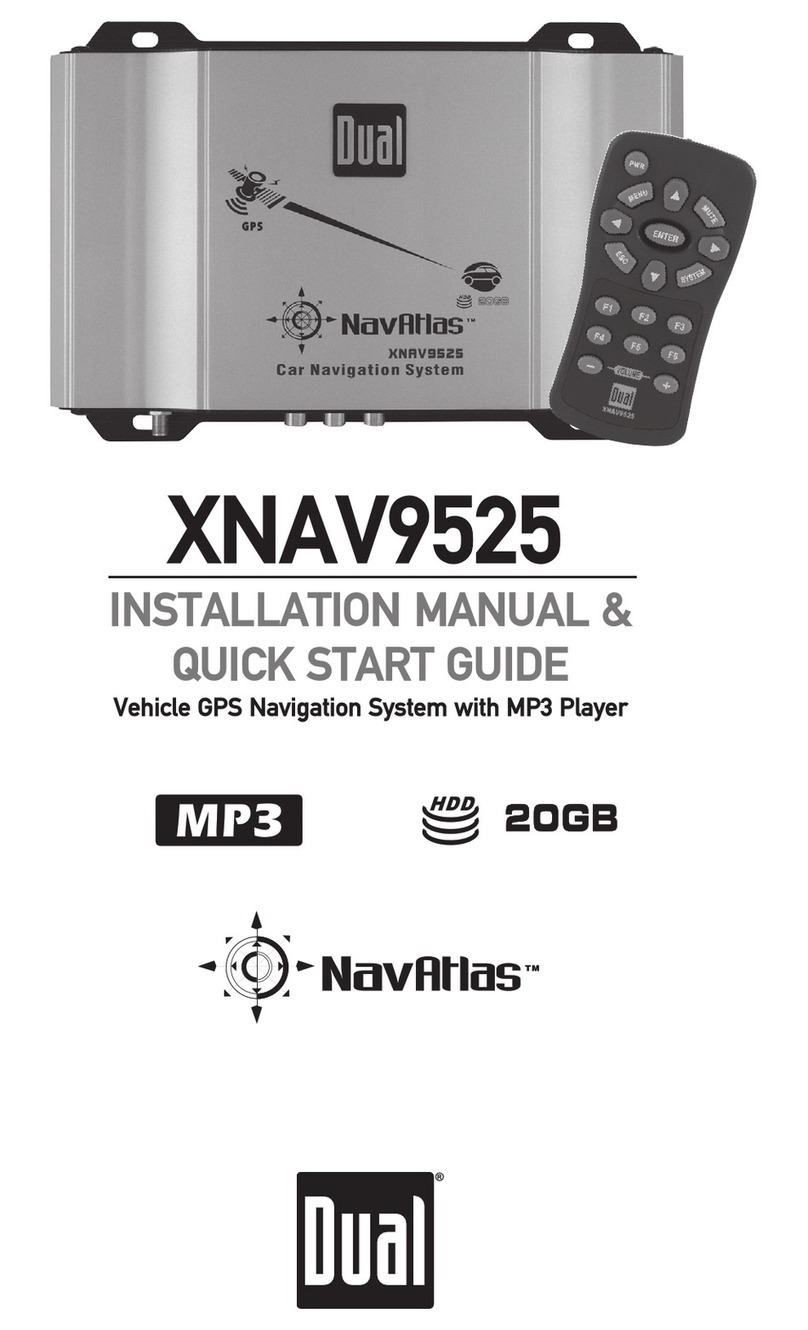
Dual
Dual NavAtlas XNAV9525 Installation manual & quick start guide

Garmin
Garmin StreetPilot GPS Owner's manual and reference guide
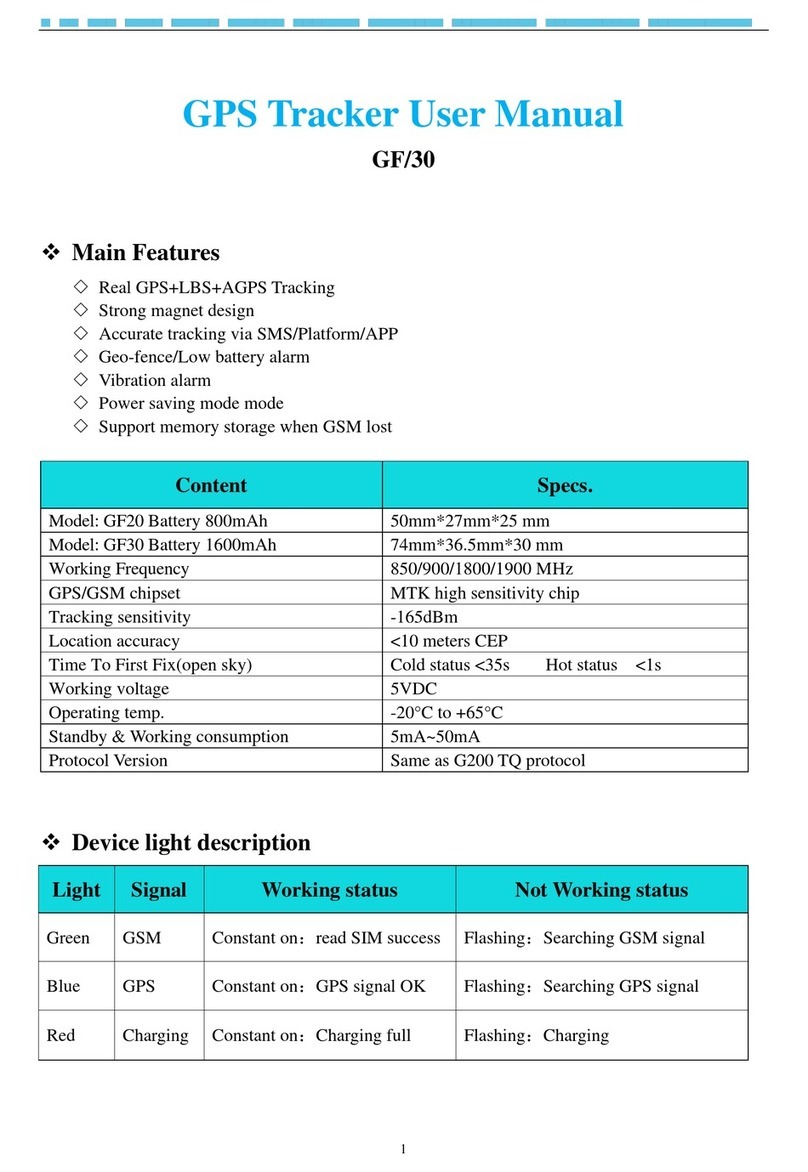
Cantrack
Cantrack GF20 user manual
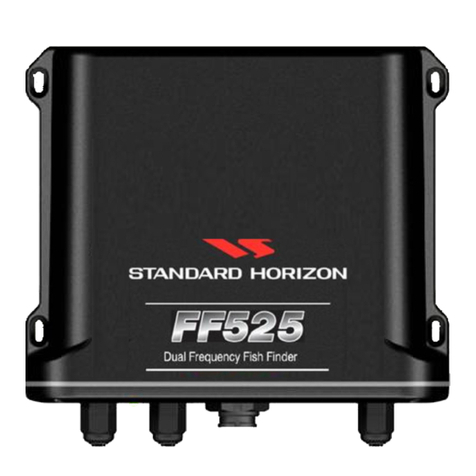
Standard Horizon
Standard Horizon FF525 Operation manual

Becker
Becker TRAFFIC ASSIST 7977 Instructions for use
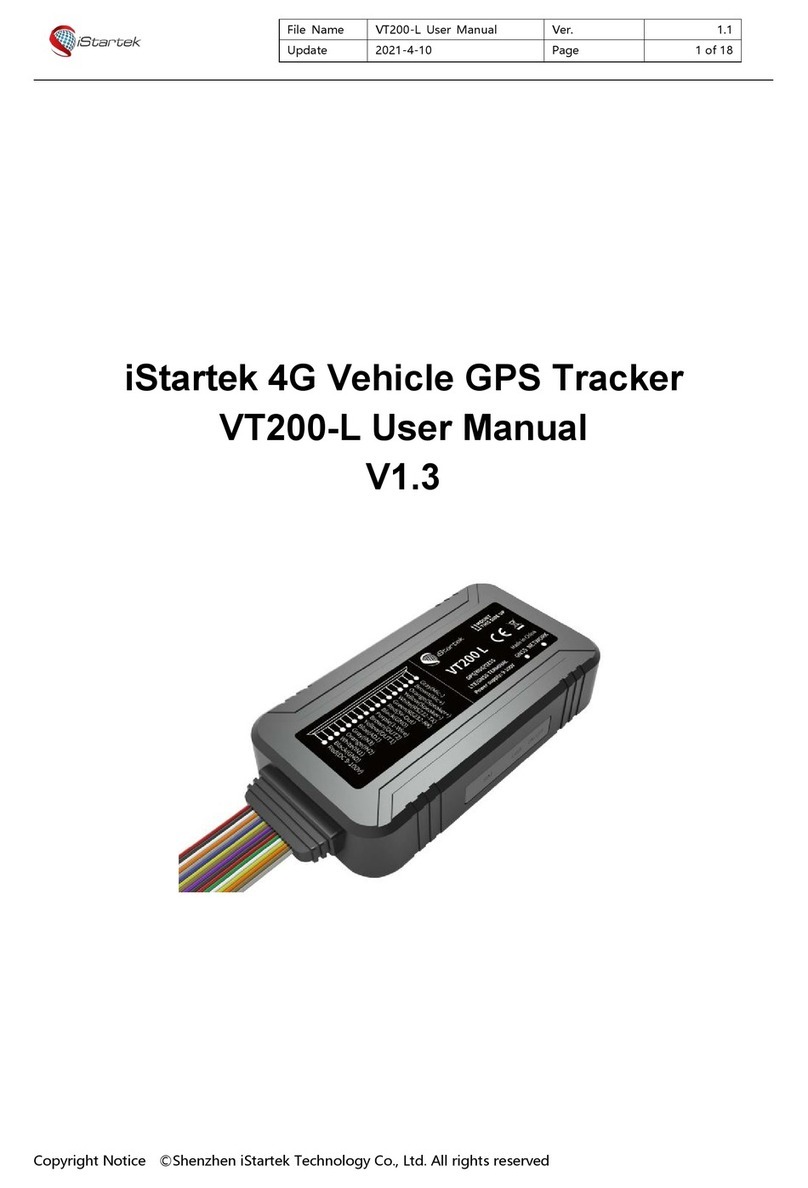
iStartek
iStartek VT200-L user manual
